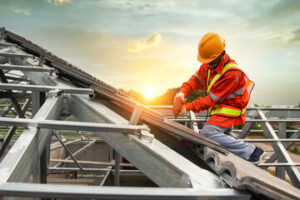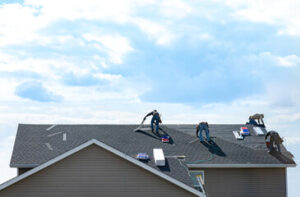The roof is a vital component of every building structure, protecting it from environmental elements. It also adds a distinctive architectural appeal to the structure. Therefore, understanding Roofing Helena MT basics is essential for any homeowner looking to repair or replace their roof.

Asphalt shingles are a common choice due to their affordability and durability. Other options include clay or concrete tiles and natural slates, which add a sophisticated look to homes.
Insulation is an integral component of any roofing system. It provides an insulated barrier that helps to regulate indoor temperatures and reduce energy consumption. It also protects against moisture damage and makes for a healthier and more comfortable living environment. In addition to being cost-effective, proper roof insulation can also increase a home’s value and improve its overall durability.
Different types of insulation are available to suit different needs. For example, fiberglass batts are a popular choice because they’re affordable, easy to install and have a decent R-value for most climates. Other options include spray foam insulation, which expands on application to seal any gaps or cracks and has a higher R-value than fiberglass. It’s also water-resistant and doesn’t attract rodents like fiberglass.
For commercial roofing systems, high-density extruded polystyrene (XPS) is an excellent option. It has a good R-value, is resistant to chemicals and toxins and offers an extended service life of up to 40 years. It is also very lightweight, making it ideal for retrofits and can be cut to accommodate roof penetrations and other features.
Another type of insulation is EPS, which is similar to the styrofoam used in packaging but manufactured into sheets that are thicker. Compared to XPS, it has a lower R-value but is still an excellent insulator. It’s also a lot more permeable to air and moisture, which can make it a better choice for some applications.
Cellulose insulation is another environmentally friendly option that can be blown or sprayed into attics. It’s made from recycled paper and plant-based materials, so it’s more sustainable than other choices. It’s also a little less expensive than other types of insulation and has a R-value of 2.9-3.8 per inch.
Other less common types of insulation include reflective barriers, which can be installed in attics to bounce radiant heat back, reducing cooling costs in the summer. They’re often combined with other types of insulation for enhanced performance. Another is SIPs, which are prefabricated panels that sandwich rigid foam insulation between two structural boards, such as oriented strand board or OSB.
Durability
Durability in a roofing system is an important consideration when choosing materials, as it determines the longevity of the structure. Whether your building will be used for commercial or residential purposes, a durable roof helps ensure safety and comfort throughout its lifespan by preventing the infiltration of water, air, and other elements. The durability of a roofing system also plays an important role in energy efficiency, with some materials offering better protection from heat and cooling than others.
When choosing a roofing material, it’s important to set a budget that includes the cost of materials as well as installation and maintenance costs. Different roofing products have varying levels of durability, with some options like asphalt shingles being more budget-friendly while other options like metal require a higher upfront investment but offer increased longevity and aesthetics.
The type of weather in your region can also play a factor in the durability of your roofing system. For example, if you live in an area with frequent hailstorms, you might want to consider a more resilient material like slate that can last for decades or even a century with regular maintenance.
Additionally, the durability of a roofing system is determined by its impact resistance. Some roofing materials like metal can withstand extreme weather conditions and debris, ensuring long-term durability. Other materials, such as clay or concrete tiles, are highly resistant to fire and can withstand heavy snowfall.
In addition to the overall durability of a roofing system, you should also consider the durability of its components. For example, the underlayment, which adds a layer of insulation and protection underneath the shingles, should be made from a waterproof material like felt or synthetic underlayment.
The overall durability of a roofing system is dependent on the quality of its materials, design, and construction. By following best practices, property owners can ensure a long-lasting, durable roofing system that provides protection and support for the rest of the structure.
Aesthetics
Your roof doesn’t just protect against weather and elements; it also defines a building’s visual appeal and architectural character. Symmetry and balance, color harmony, and alignment with the overall design of a home are essential roofing aesthetics that help elevate curb appeal. Whether it’s traditional shingles that complement a charming cottage or sleek metal roofs that lend an industrial feel to modern structures, choosing the right roofing material, style, and colors will ensure a seamless integration between form and function.
Moreover, innovative roofing materials and styles are introducing new levels of sustainability and energy efficiency while offering striking visual appeal. From solar-powered green roofs to water harvesting systems, these roofing aesthetics are shaping the future of sustainable building. This exploration will delve into the many critical aspects of aesthetics in roofing, demonstrating how the right material, shape, and color can make a dramatic impact on the allure of any structure.
Maintenance
The roof is the outermost covering of a building that protects against rain, snow, sun and wind. It consists of the framework, decking, and outermost layer of materials (such as shingles, tiles or metal panels). A roofing system is designed to provide a thermal barrier between indoors and outdoors and provide insulation from heat and cold, sound, and UV radiation.
Maintenance in a roofing system is critical to maintain the performance, life cycle and aesthetics of a roof. A roofing professional can help to develop a maintenance program that includes periodic inspections, repair of minor defects and replacement of components as needed. This will also help to extend the life of the roofing system and ensure that it performs at its peak.
Generally, the frequency of maintenance required will vary based on the environment in which the building is located. A residential building in a mild climate might require surface maintenance only once or twice per year, while a commercial structure in a harsher climate might need more frequent and/or thorough maintenance.
Inspecting a roof system on a regular basis, preferably on a semi-annual schedule in spring and fall, will allow the roofing professionals to identify any early problems before they become major issues. This can also save thousands of dollars in repair costs as compared to repairing the damage once it becomes apparent.
The roofing professionals will inspect the roof for a variety of conditions including:
Moisture infiltration into a building can lead to the damage of interior finishes, furnishings and inventory or finished goods. Moreover, it can damage the structural integrity of the roof or building components and promote the growth of mold. It is therefore important to keep the moisture infiltration at a minimum.
Other factors that can cause problems with the roof system include changes in the use and occupancy of a building other than those for which it was designed; ongoing water infiltration or condensation infiltration; and poor design, installation or repair of the roof system. The CRCA National Technical Committee recommends a full site visit and preventative maintenance by a qualified roofing contractor on a warranted low-slope assembly, or steep-sloped membrane, PVC or TPO roof system.
